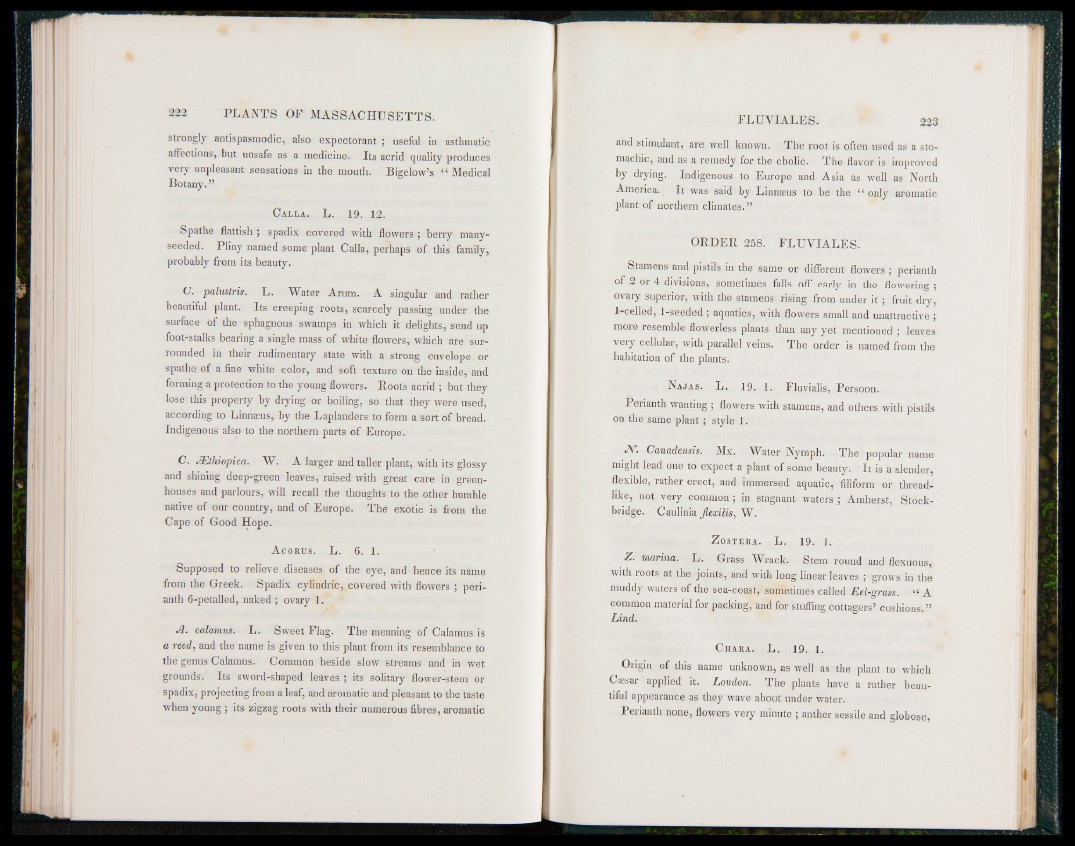
strongly antispasmodic, also expectorant ; useful in asthmatic
affections, but unsafe as a medicine. Its acrid quality produces
very unpleasant sensations in the mouth. Bigelow’s £t Medical
Botany.”
Calla. L. 19. 12.
Spathe flattish ; spadix covered with flowers ; berry many-
seeded. Pliny named some plant Calla, perhaps of this family,
probably from its beauty.
C. palustris. L. Water Arum. A singular and rather
beautiful plant. Its creeping roots, scarcely passing under the
surface of the sphagnous swamps in which it delights, send up
foot-stalks bearing a single mass of white flowers, which are surrounded
in their rudimentary state with a strong envelope or
spathe^of a fine white color, and soft texture on the inside, and
forming a protection to the young flowers. Roots acrid ; but they
lose this property by drying or boiling, so that they were used,
according to Linnaeus, by the Laplanders to form a sort of bread.
Indigenous also to the northern parts of Europe.
C. JEthiopica. W. A larger and taller plant, with its glossy
and shining deep-green leaves, raised with great care in greenhouses
and parlours, will recall the thoughts to the other humble
native of our country, and of Europe. The exotic is from the
Cape of Good Hope.
A corus. L. 6. 1.
Supposed to relieve diseases of the eye, and hence its name
from the Greek. Spadix cylindric, covered with flowers ; perianth
6-petalled, naked ; ovary 1.
A. calamus. L. Sweet Flag. The meaning of Calamus is
a reed, and the name is given to this plant from its resemblance to
the genus Calamus. Common beside slow streams and in wet
grounds: Its sword-shaped leaves ; its solitary flower-stem or
spadix, projecting from a leaf, and aromatic and pleasant to the taste
when young ; its zigzag roots with their numerous fibres, aromatic
and stimulant, are well known. The root is often used as a stomachic,
and as a remedy for the cholic. The flavor is improved
by drying. Indigenous to Europe and Asia as well as North
America. It was said by Linnaeus to be the “ only aromatic
plant of northern climates.”
ORDER 258. FLUV IA LE S.
Stamens and pistils in the same or different flowers ; perianth
of 2 or 4 divisions, sometimes falls off early in the flowering ;
ovary superior, with the stamens rising from under i t ; fruit dry,
4-celled, 1-seeded; aquatics, with flowers small and unattractive ;
more resemble flowerless plants than any yet mentioned ; leaves'
very cellular, with parallel veins. The order is named from the
habitation of the plants.
Najas. L. 19. 1. Fluvialis, Persoon.
Perianth wanting ; flowers with stamens, and others with pistils
on the same plant; style 1.
JST. Canadensis. Mx. Water Nymph. The popular name
might lead one to expect a plant of some beauty. It is a slender,
flexible, rather erect, and immersed aquatic, filiform or threadlike,
not very common; in stagnant waters ; Amherst, Stock-
bridge. Caulinia Jlexilis, W.
Z ostera. L., 19. 1.
Z. marina. L. Grass Wrack. Stem round and flexuous,
with roots at the joints, and with long linear leaves ; grows in the
muddy waters of the sea-coast, sometimes called Eel-grass. “ A
common material for packing, and for stuffing cottagers’ cushions.”
Lind.
Chara. L . 19. l.
Origin of this name unknown, as well as the plant to which
Caesar applied it. Loudon. The plants have a rather beautiful
appearance as they wave about under water.
Perianth none, flowers very minute ; anther sessile and globose,